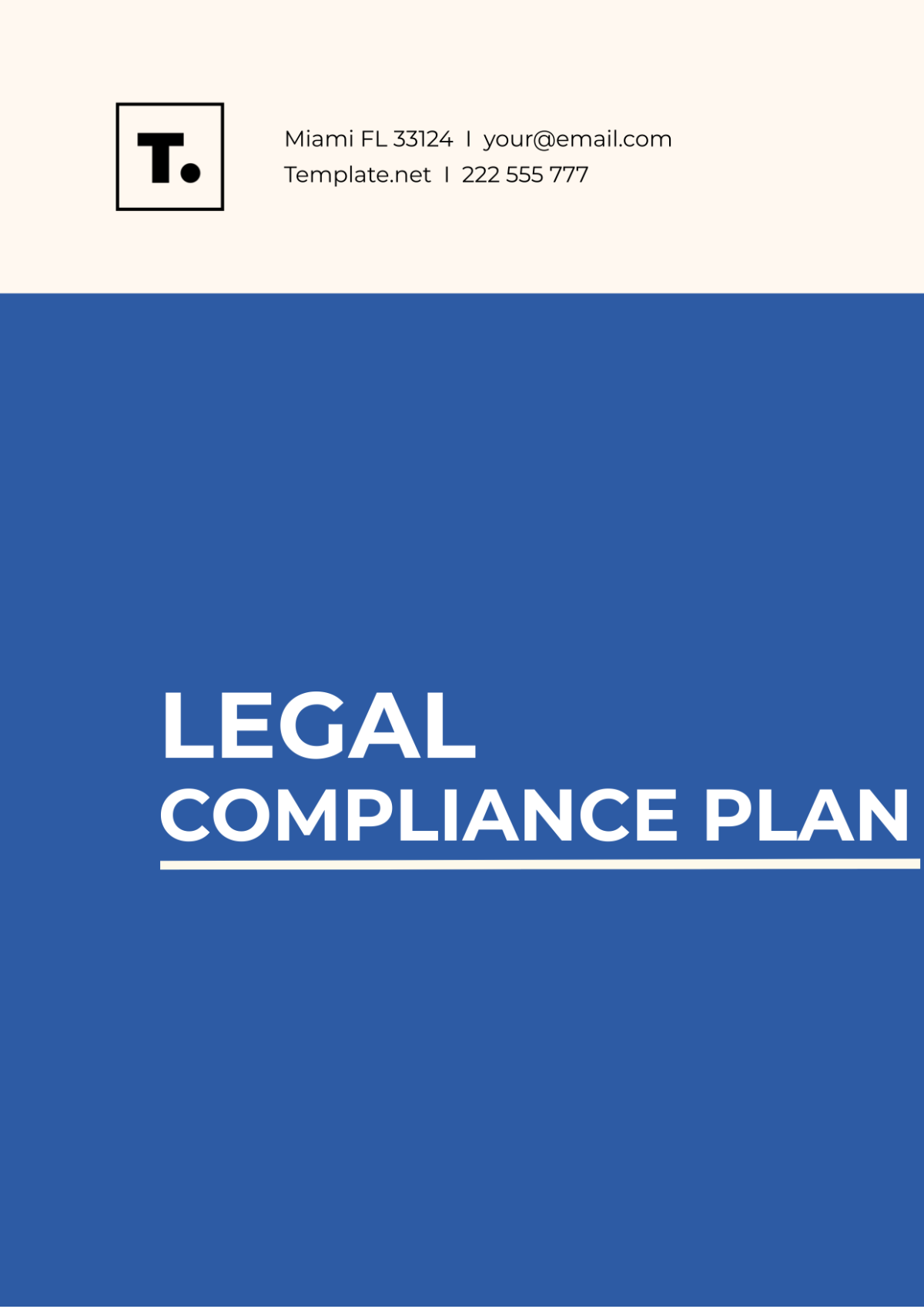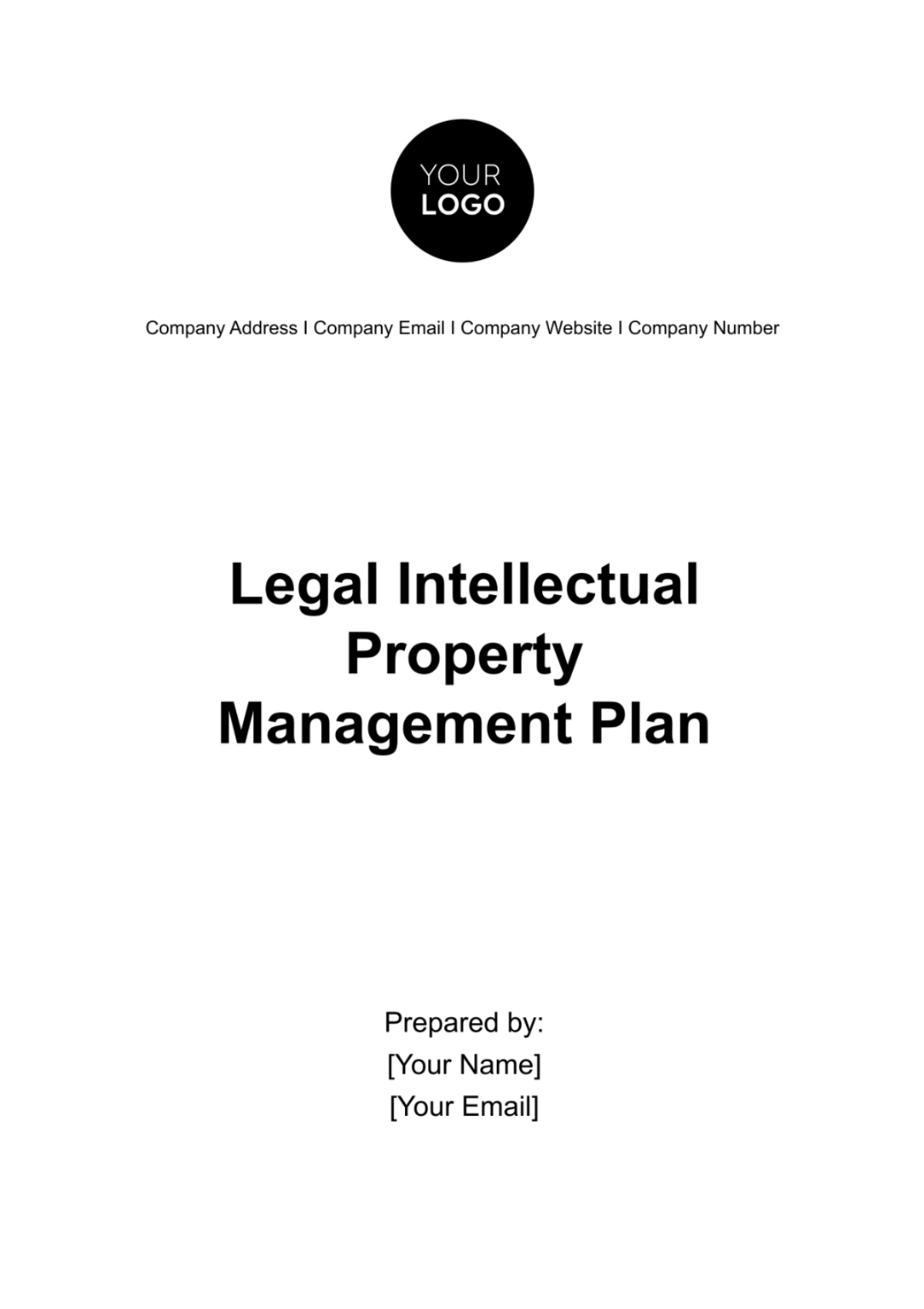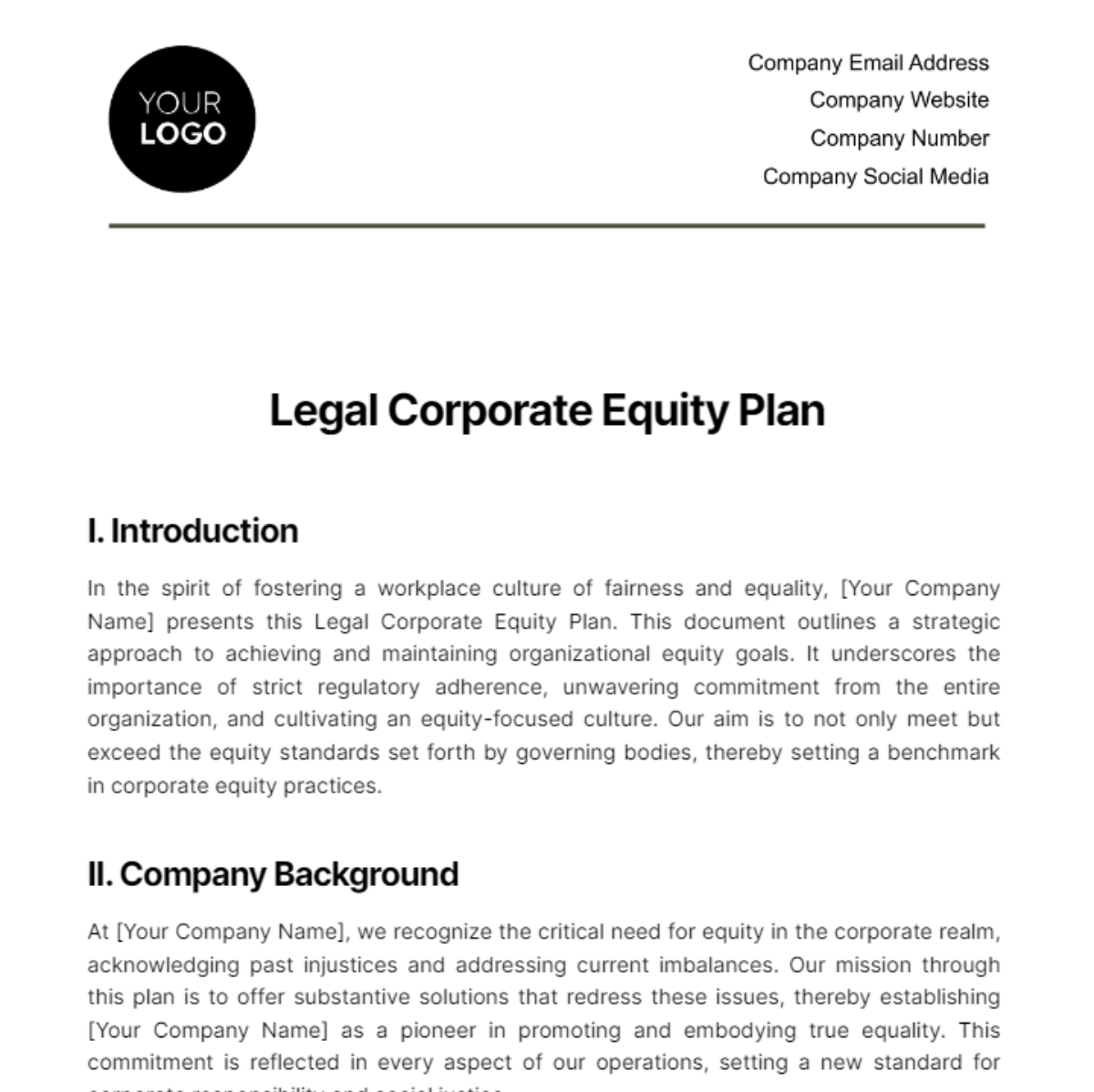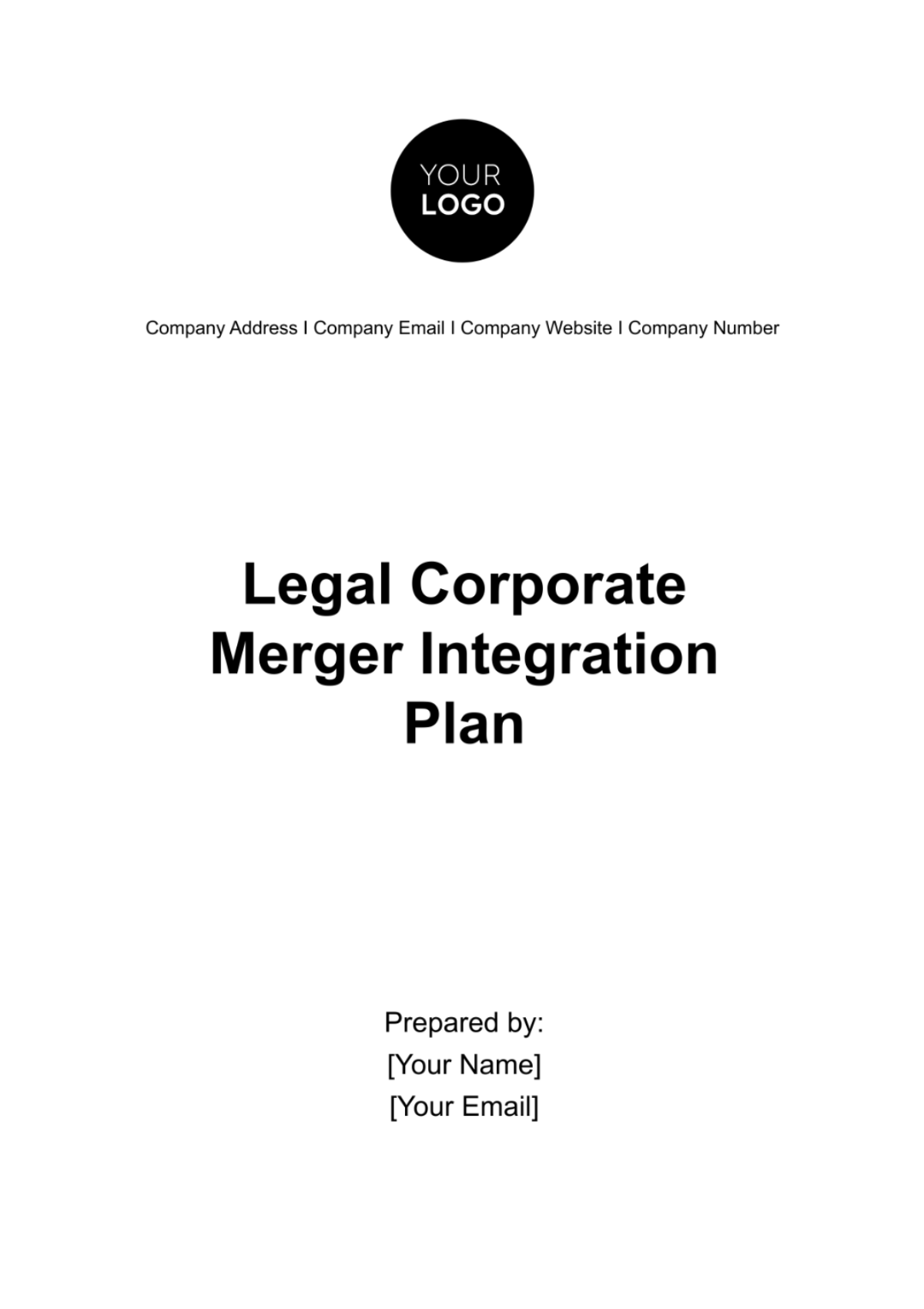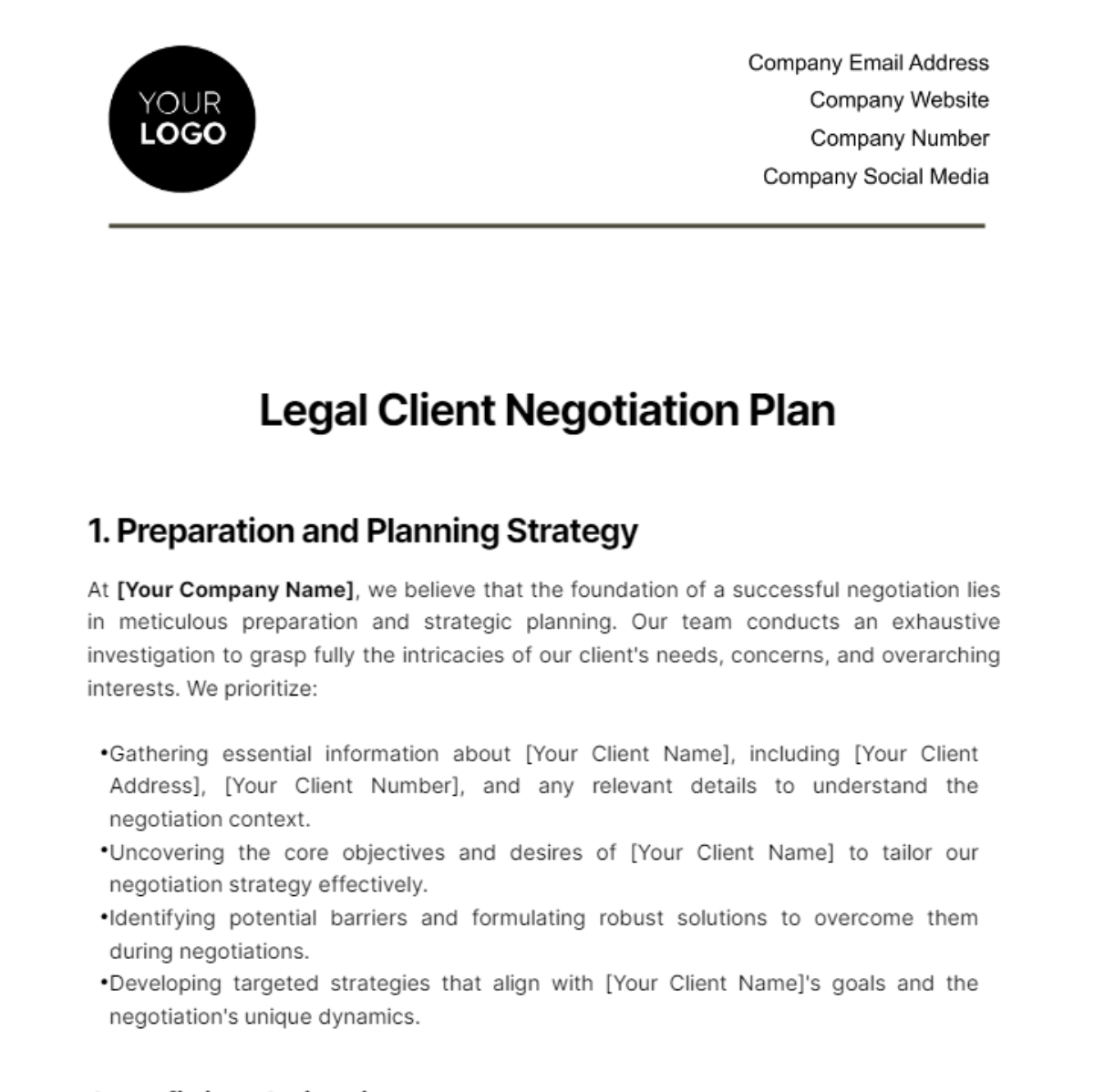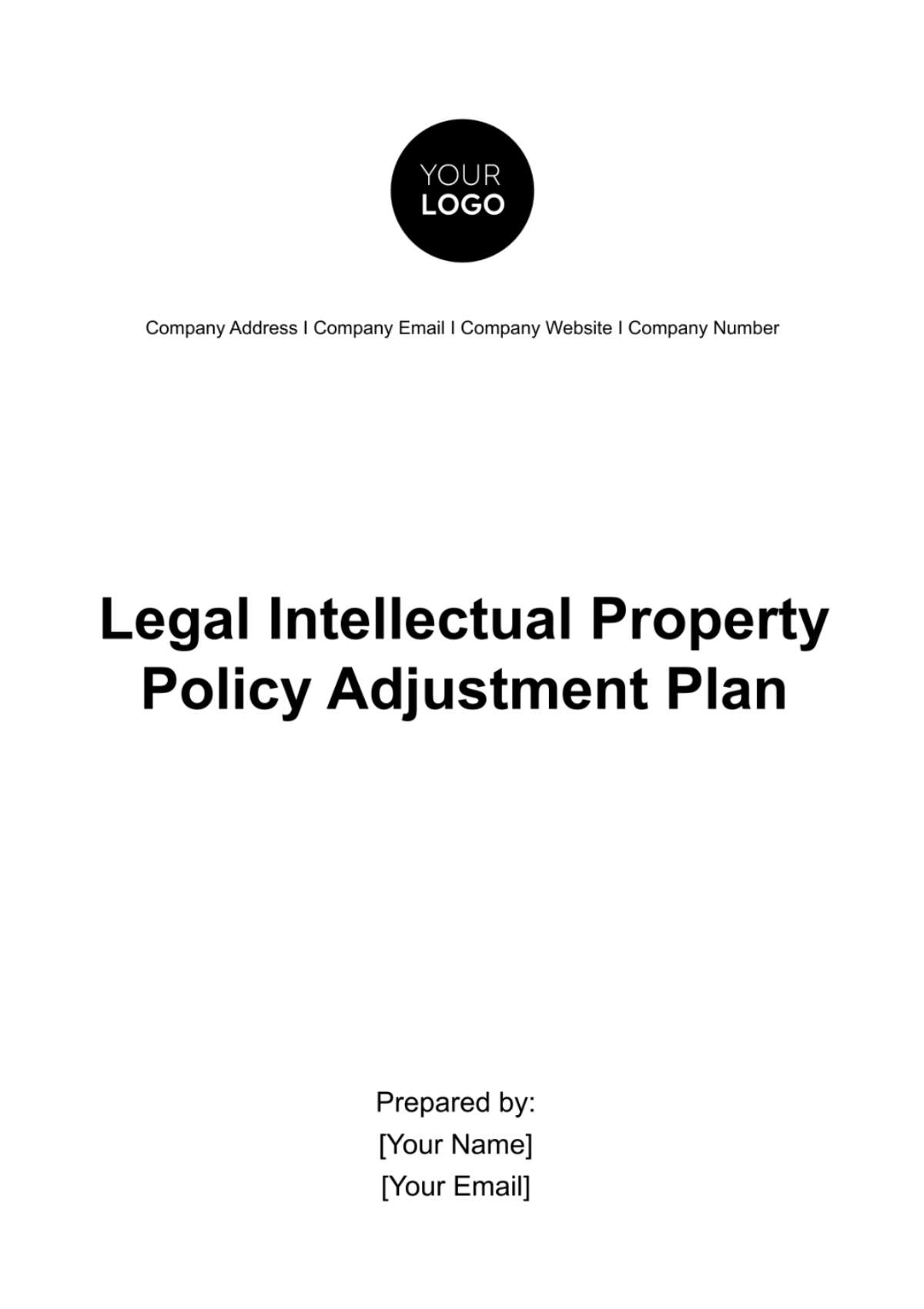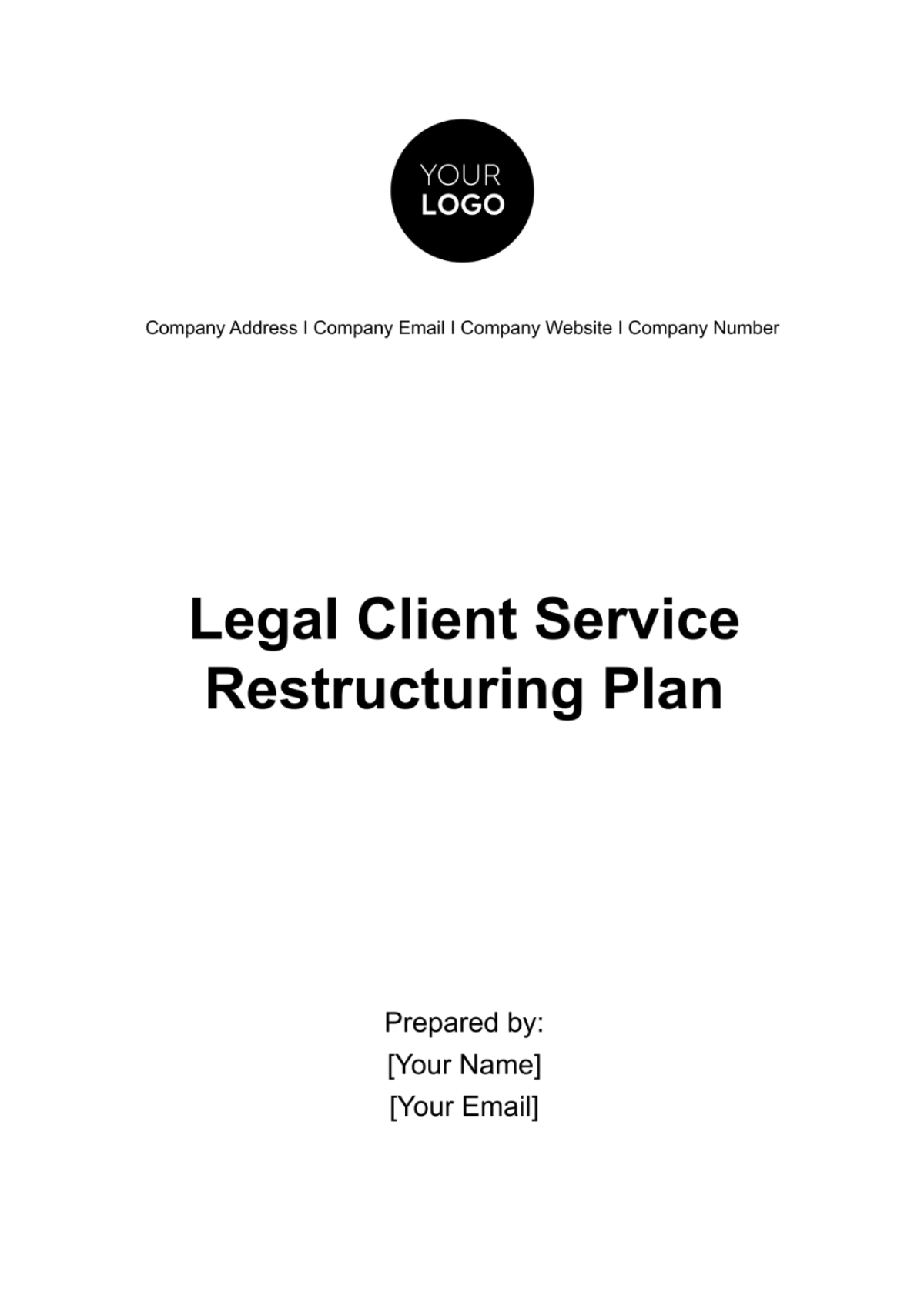Legal Intellectual Property Strategy And Execution Plan
I. Introduction
Welcome to the Intellectual Property (IP) Strategy and Execution Plan for [Your Company Name]. In today's fast-paced and competitive [industry] landscape, safeguarding intellectual property assets is paramount to maintaining a competitive edge and fostering innovation. This document outlines our comprehensive approach to managing and protecting our valuable intellectual property assets.
At [Your Company Name], we recognize the significance of intellectual property in driving business growth and enhancing shareholder value. Our IP Strategy and Execution Plan is designed to align with our overall business objectives while ensuring robust protection of our IP assets across various domains including patents, trademarks, copyrights, and trade secrets.
This document serves as a guide for our stakeholders, outlining key strategies, processes, and best practices for managing intellectual property effectively. By implementing the strategies outlined in this plan, we aim to secure our IP assets, mitigate risks, and capitalize on opportunities for commercialization and revenue generation.
II. Executive Summary
A. Overview of Intellectual Property
Intellectual property encompasses a wide range of intangible assets that are critical to the success of [Your Company Name]. These assets include inventions, brand identities, creative works, and confidential information that provide us with a competitive advantage in the marketplace. Effective management of intellectual property is essential for protecting our innovations, enhancing market position, and driving business growth.
B. Importance of IP Protection
In today's digital economy, intellectual property theft and infringement pose significant risks to businesses across all sectors. Without adequate protection, our valuable IP assets may be vulnerable to unauthorized use, reproduction, or exploitation by competitors. By implementing robust IP protection measures, we can safeguard our innovations, maintain market exclusivity, and preserve the integrity of our brand.
C. Objectives of the IP Strategy and Execution Plan
The primary objectives of our IP Strategy and Execution Plan are as follows:
Identify and assess our intellectual property assets comprehensively.
Develop tailored protection strategies for each category of IP asset.
Implement proactive measures to detect and prevent IP infringement.
Strengthen our IP enforcement capabilities through strategic litigation and enforcement actions.
Optimize the commercialization and monetization of our IP assets through licensing and partnership agreements.
Cultivate a culture of IP awareness and compliance across the organization.
D. Key Strategies for IP Management
Our IP Strategy and Execution Plan encompasses a range of key strategies aimed at maximizing the value of our intellectual property assets. These strategies include:
Patent portfolio management to protect our inventions and technological innovations.
Trademark registration and enforcement to safeguard our brand identity and goodwill.
Copyright protection for our creative works, software, and digital content.
Trade secret management to safeguard confidential information and proprietary processes.
Collaboration with legal counsel to develop and implement effective IP enforcement strategies.
III. IP Portfolio Assessment
A. Identification of IP Assets
In order to conduct a comprehensive assessment of our intellectual property portfolio, [Your Company Name] will initiate an inventory process to identify all relevant IP assets. This includes:
Patents: Documentation of all granted patents, pending patent applications, and inventions eligible for patent protection.
Trademarks: Identification of registered trademarks, pending trademark applications, and unregistered marks associated with our brand.
Copyrights: Compilation of copyrighted materials, including software code, creative works, and digital content produced by [Your Company Name].
Trade Secrets: Identification of proprietary information, confidential processes, and know-how that provide a competitive advantage.
B. Evaluation of Existing IP Portfolio
Once all IP assets have been identified, [Your Company Name] will conduct a thorough evaluation to assess the strength, value, and relevance of each asset within the portfolio. This evaluation will consider factors such as:
Market relevance and commercial potential of patented inventions.
Strength and distinctiveness of registered trademarks in the marketplace.
Originality and creative expression of copyrighted works.
Confidentiality and strategic importance of trade secrets to the business.
C. Gap Analysis and Identification of Areas for Improvement
Based on the evaluation of our existing IP portfolio, [Your Company Name] will perform a gap analysis to identify any areas of weakness or opportunities for improvement. This may include:
Identifying gaps in patent coverage for key technologies or product lines.
Assessing the adequacy of trademark protection in key markets or product categories.
Reviewing copyright registration status and identifying works that may require additional protection.
Evaluating the effectiveness of trade secret protection measures and identifying areas for enhancement.
D. Risk Assessment and Mitigation Strategies
As part of the IP portfolio assessment, [Your Company Name] will conduct a risk assessment to identify potential threats to our intellectual property assets. This may include risks such as:
Infringement by competitors or third parties.
Misappropriation of trade secrets by employees or business partners.
Failure to adequately protect IP assets, leading to loss of exclusivity or market advantage.
Based on the findings of the risk assessment, [Your Company Name] will develop and implement mitigation strategies to address identified risks and vulnerabilities. These may include:
Strengthening internal controls and policies to protect confidential information.
Enhancing employee training and awareness programs on IP rights and responsibilities.
Implementing technology solutions to monitor and detect potential IP infringement or misuse.
IV. IP Protection Strategies
A. Patents
Patent Application Process
[Your Company Name] will develop a systematic approach to the patent application process, including:
Conducting prior art searches to assess the novelty and patentability of inventions.
Drafting high-quality patent applications with comprehensive claim coverage.
Filing patent applications in key jurisdictions to secure global protection.
Engaging with patent examiners to address any objections or challenges during the examination process.
Patent Portfolio Management
Once patents are granted, [Your Company Name] will implement a proactive approach to patent portfolio management, including:
Regular review and maintenance of patent portfolios to assess ongoing relevance and value.
Monitoring competitor activity and potential infringement of patented technologies.
Pursuing enforcement actions against infringers to protect our intellectual property rights.
B. Trademarks
Trademark Registration Process
[Your Company Name] will develop a strategic approach to trademark registration, including:
Conducting comprehensive trademark searches to assess availability and registrability of marks.
Filing trademark applications for key brand names, logos, and slogans in relevant jurisdictions.
Monitoring trademark registries and opposing any conflicting or infringing trademark applications.
Trademark Enforcement
Once trademarks are registered, [Your Company Name] will implement proactive enforcement strategies, including:
Monitoring for unauthorized use or infringement of registered trademarks.
Sending cease and desist letters to infringing parties and pursuing legal action if necessary.
Collaborating with law enforcement agencies and customs authorities to combat counterfeiting and piracy.
C. Copyrights
Copyright Registration Process
[Your Company Name] will establish procedures for copyright registration, including:
Identifying works eligible for copyright protection, such as software code, literary works, and artistic creations.
Registering copyrights with relevant copyright offices to establish prima facie evidence of ownership.
Displaying copyright notices on protected works to deter unauthorized use and infringement.
Copyright Enforcement
Once copyrights are registered, [Your Company Name] will implement measures to enforce copyright protection, including:
Monitoring for unauthorized reproduction or distribution of copyrighted works.
Sending DMCA takedown notices to internet service providers and online platforms hosting infringing content.
Pursuing legal action against infringers to obtain injunctive relief and monetary damages.
D. Trade Secrets
Trade Secret Protection Measures
[Your Company Name] will implement robust measures to protect trade secrets, including:
Restricting access to confidential information on a need-to-know basis.
Implementing physical and technological safeguards to prevent unauthorized disclosure.
Executing non-disclosure agreements with employees, contractors, and business partners to maintain confidentiality.
Trade Secret Management
[Your Company Name] will establish procedures for managing trade secrets, including:
Documenting and cataloging trade secrets to facilitate identification and protection.
Implementing policies and procedures for handling confidential information securely.
Conducting regular audits and assessments to ensure compliance with trade secret protection measures.
V. IP Enforcement and Litigation
A. Monitoring and Detection of IP Infringement
[Your Company Name] will establish a proactive monitoring system to detect potential IP infringement. This system will include:
Regular monitoring of marketplaces, websites, and social media platforms for unauthorized use of our IP assets.
Utilization of online monitoring tools and services to identify instances of infringement or misuse.
Collaboration with industry associations and legal partners to stay informed about emerging IP infringement trends.
B. Cease and Desist Actions
Upon identification of IP infringement, [Your Company Name] will initiate cease and desist actions to stop unauthorized use of our intellectual property. This process includes:
Sending formal cease and desist letters to infringing parties, demanding immediate cessation of infringing activities.
Offering infringers the opportunity to enter into licensing agreements to legitimize their use of our IP assets.
Taking swift legal action against persistent infringers who fail to comply with cease and desist demands.
C. Alternative Dispute Resolution
In cases where litigation may not be the most efficient or cost-effective option, [Your Company Name] will explore alternative dispute resolution methods, such as:
Mediation: Engaging a neutral third party to facilitate discussions and negotiations between parties involved in an IP dispute.
Arbitration: Submitting the dispute to an impartial arbitrator for a binding decision, avoiding the time and expense associated with traditional litigation.
Negotiated settlements: Working collaboratively with infringing parties to reach mutually acceptable resolutions outside of court.
D. Litigation Strategy and Management
When litigation is necessary to protect our intellectual property rights, [Your Company Name] will develop a strategic approach to litigation management, including:
Conducting a thorough risk assessment to evaluate the likelihood of success and potential costs associated with litigation.
Engaging experienced intellectual property litigators with a track record of success in similar cases.
Developing a litigation strategy tailored to the specific circumstances of each case, including pre-trial motions, discovery, and trial preparation.
Implementing effective case management practices to minimize delays and control costs throughout the litigation process.
Communicating regularly with stakeholders and providing updates on the status of litigation proceedings.
VI. IP Licensing and Commercialization
A. Licensing Strategies
[Your Company Name] will develop a comprehensive licensing strategy to maximize the commercial value of our intellectual property assets. This strategy includes:
Identifying potential licensing opportunities for our patents, trademarks, copyrights, and trade secrets.
Evaluating potential licensees based on their industry experience, market reach, and financial stability.
Negotiating licensing agreements that balance our need for revenue generation with the licensee's desire for access to valuable IP assets.
Implementing licensing programs that allow for flexibility in pricing, royalties, and terms to accommodate varying business models and market conditions.
B. Negotiation and Drafting of Licensing Agreements
[Your Company Name] will engage in proactive negotiations and drafting of licensing agreements to ensure favorable terms and conditions. This includes:
Conducting thorough due diligence to assess the licensee's ability to comply with the terms of the agreement and protect our IP assets.
Drafting clear and enforceable licensing agreements that define the scope of licensed rights, usage restrictions, royalty payments, and termination provisions.
Negotiating fair and equitable terms that reflect the value of our IP assets while providing incentives for the licensee to invest in commercialization efforts.
C. Royalty Management and Revenue Generation
[Your Company Name] will implement effective royalty management practices to track and collect royalties from licensees. This includes:
Establishing robust royalty tracking systems to monitor usage of licensed IP assets and calculate royalty payments accurately.
Issuing timely invoices and statements to licensees and following up on overdue payments as necessary.
Conducting regular audits of licensee compliance to ensure accurate reporting and payment of royalties.
Reinvesting royalty revenue into research and development efforts to drive innovation and strengthen our IP portfolio.
D. Technology Transfer and Commercialization Opportunities
[Your Company Name] will explore opportunities for technology transfer and commercialization of our intellectual property assets. This includes:
Collaborating with research institutions, universities, and government agencies to identify potential technology transfer opportunities.
Participating in industry conferences, trade shows, and networking events to showcase our innovations and attract potential partners.
Negotiating technology transfer agreements that facilitate the transfer of technology from [Your Company Name] to third parties for commercialization purposes.
Providing support and resources to licensees to facilitate the successful commercialization of licensed technologies and maximize their market impact.
VII. IP Education and Awareness
A. Training Programs for Employees
[Your Company Name] recognizes the importance of fostering a culture of intellectual property awareness and compliance among employees. To achieve this, we will implement comprehensive training programs covering various aspects of intellectual property, including:
Intellectual property basics: An overview of different types of IP assets, their importance, and how they contribute to [Your Company Name]'s success.
IP rights and responsibilities: Educating employees about their roles and responsibilities in protecting and respecting intellectual property, including confidentiality obligations and reporting requirements.
IP management best practices: Providing practical guidance on how to identify, protect, and manage intellectual property assets in day-to-day operations.
IP enforcement and compliance: Training employees on how to recognize and respond to potential IP infringement or misuse, including reporting procedures and escalation protocols.
B. Stakeholder Engagement and Communication
In addition to employee training, [Your Company Name] will engage with stakeholders at all levels of the organization to promote IP awareness and compliance. This includes:
Regular communication and updates on intellectual property policies, procedures, and best practices through internal channels such as newsletters, intranet portals, and company meetings.
Facilitating open dialogue and collaboration between departments to share knowledge and best practices related to IP management.
Encouraging feedback and suggestions from employees on how to improve IP education and awareness initiatives to better meet their needs and concerns.
C. Compliance and Best Practices
[Your Company Name] will establish mechanisms to monitor and enforce compliance with intellectual property policies and best practices. This includes:
Regular audits and assessments to evaluate compliance with IP policies and identify areas for improvement.
Implementing consequences for non-compliance with IP policies, including disciplinary action for employees who violate intellectual property rights or fail to follow established procedures.
Recognizing and rewarding employees who demonstrate exceptional commitment to IP protection and compliance through incentive programs and performance evaluations.
VIII. IP Policy Development
A. Development of Internal IP Policies
[Your Company Name] will develop and implement comprehensive internal IP policies to govern the management, protection, and enforcement of intellectual property assets. These policies will cover key areas such as:
IP ownership: Clarifying rights and responsibilities regarding the creation, ownership, and assignment of intellectual property developed by employees in the course of their employment.
Confidentiality and non-disclosure: Establishing protocols for protecting confidential information and trade secrets from unauthorized disclosure or misuse.
IP enforcement: Outlining procedures for identifying, reporting, and addressing potential IP infringement or misuse, including escalation pathways and enforcement mechanisms.
Compliance requirements: Communicating expectations for employees to comply with applicable laws, regulations, and industry standards related to intellectual property.
Training and education: Detailing requirements for employee training and awareness programs on intellectual property rights and responsibilities.
B. Guidelines for IP Ownership and Assignment
[Your Company Name] will establish clear guidelines for determining ownership and assignment of intellectual property rights, including:
Specifying conditions under which [Your Company Name] will assert ownership over intellectual property created by employees, contractors, or third parties.
Establishing procedures for documenting and recording intellectual property ownership, including the use of invention disclosure forms, assignment agreements, and recordkeeping systems.
Providing guidance on the allocation of intellectual property rights in collaborative research and development projects involving multiple parties, including joint ownership arrangements and licensing agreements.
C. Confidentiality and Non-Disclosure Policies
[Your Company Name] will implement robust confidentiality and non-disclosure policies to protect sensitive information and trade secrets from unauthorized disclosure or misuse. These policies will include:
Clear definitions of confidential information and trade secrets, including examples of types of information covered by the policies.
Requirements for employees to sign non-disclosure agreements (NDAs) before accessing confidential information or trade secrets.
Procedures for marking and handling confidential information to ensure it is protected from unauthorized disclosure or access.
Consequences for violating confidentiality and non-disclosure policies, including disciplinary action and legal remedies for breaches of confidentiality obligations.
IX. IP Budgeting and Resource Allocation
A. Allocation of Financial Resources for IP Protection
[Your Company Name] recognizes the importance of allocating sufficient financial resources to support the protection and management of intellectual property assets. To ensure effective IP protection, we will allocate budgetary resources as follows:
Expense Category | Allocation ($) |
|---|---|
Patent application fees | [$000,000] |
Trademark registration fees | [$000,000] |
Copyright registration fees | [$000,000] |
Trade secret protection measures | [$000,000] |
Legal fees for IP enforcement | [$000,000] |
Technology and software tools | [$000,000] |
Employee training and education | [$000,000] |
Other miscellaneous expenses | [$000,000] |
Total | [$0,000,000] |
B. Resource Planning for IP Management Activities
In addition to financial resources, [Your Company Name] will allocate human and technological resources to support IP management activities. This includes:
Assigning dedicated personnel, such as IP attorneys, patent agents, and IP specialists, to oversee the execution of the IP Strategy and Execution Plan.
Providing training and professional development opportunities for employees involved in IP management activities to enhance their skills and expertise.
Investing in technology solutions, such as IP management software and monitoring tools, to streamline IP portfolio management and enforcement processes.
Collaborating with external service providers, such as law firms and IP consultants, to supplement internal resources and expertise as needed.
C. ROI Analysis and Performance Metrics
[Your Company Name] will conduct regular return on investment (ROI) analysis to evaluate the effectiveness of our IP protection efforts and resource allocation decisions. Key performance metrics will include:
Number of patents, trademarks, copyrights, and trade secrets secured or enforced.
Reduction in IP infringement incidents and associated costs.
Revenue generated through IP licensing, commercialization, and enforcement activities.
Cost savings achieved through efficient resource allocation and management.
Employee satisfaction and engagement with IP education and awareness initiatives.
X. Monitoring and Review
A. Regular Assessment of IP Strategy Effectiveness
[Your Company Name] will conduct regular assessments of the effectiveness of our IP Strategy and Execution Plan to ensure alignment with business objectives and industry best practices. This includes:
Quarterly reviews of key performance indicators and progress towards IP management goals and objectives.
Annual evaluations of the overall effectiveness of our IP protection efforts and the impact on business performance.
Periodic updates to the IP Strategy and Execution Plan based on changes in business priorities, market conditions, or regulatory requirements.
B. Benchmarking Against Industry Standards
[Your Company Name] will benchmark our IP management practices against industry standards and best practices to identify opportunities for improvement and innovation. This includes:
Participating in industry forums, conferences, and benchmarking studies to learn from leading organizations and experts in the field of IP management.
Conducting comparative analyses of our IP management practices against peer companies and industry benchmarks to identify areas of strength and weakness.
Implementing continuous improvement initiatives to adopt emerging best practices and maintain a competitive edge in IP management.
C. Continuous Improvement Initiatives
[Your Company Name] is committed to fostering a culture of continuous improvement in IP management. This includes:
Soliciting feedback from stakeholders at all levels of the organization to identify opportunities for enhancing IP management processes and practices.
Implementing innovation and research initiatives to develop new technologies, products, and services that leverage our intellectual property assets.
Investing in employee training and development programs to ensure that our team has the knowledge and skills necessary to adapt to evolving IP management challenges and opportunities.
Recognizing and celebrating successes and achievements in IP management to motivate and inspire employees to strive for excellence.
XI. Conclusion
[Your Company Name] is committed to safeguarding its intellectual property assets and maximizing their value through effective IP management strategies. By implementing the strategies outlined in this plan, we aim to strengthen our competitive position and drive innovation in the [industry] sector.
For further information or inquiries regarding the IP Strategy and Execution Plan, please contact:
[Your Name]
[Your Company Name]
[Your Company Email]

